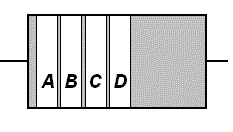Electronic color code
Electronic color codes are used to indicate the values or ratings of electronic components, near-universally for resistors, but also for capacitors, inductors, and others. They have also been used on signaling wire and cable as well, particularly for telephone and digital bus cables. The color-digit pairs used in the resistor example below are standard, but the tolerance and higher multiplier values are for resistors only.
Resistor example
band A is first significant figure of resistance value in ohms
band B is the second significant figure
band C is the decimal multiplier
band D if present, indicates tolerance of value in percent (no color means 20%)
Higher tolerance resistors use 5 bands, with three significant digits.
| Color | 1st band | 2nd band | 3rd band | Multiplier | Tolerance | Temp. Coefficient |
|---|---|---|---|---|---|---|
| Black | 0 | 0 | 0 | ×100 | ||
| Brown | 1 | 1 | 1 | ×101 | ±1% (F) | 100 ppm |
| Red | 2 | 2 | 2 | ×102 | ±2% (G) | 50 ppm |
| Orange | 3 | 3 | 3 | ×103 | 15 ppm | |
| Yellow | 4 | 4 | 4 | ×104 | 25 ppm | |
| Green | 5 | 5 | 5 | ×105 | ±0.5% (D) | |
| Blue | 6 | 6 | 6 | ×106 | ±0.25% (C) | |
| Violet | 7 | 7 | 7 | ×107 | ±0.1% (B) | |
| Gray | 8 | 8 | 8 | ×108 | ±0.05% (A) | |
| White | 9 | 9 | 9 | ×109 | ||
| Gold | ×0.1 | ±5% (J) | ||||
| Silver | ×0.01 | ±10% (K) | ||||
| None | ±20% (M) |


A useful mnemonic for remembering the first ten color codes is "Better Be Right Or Your Great Big Venture Goes West", where the first letter matches the first letter of the color code, by order of increasing magnitude.
Resistors are measured in ohms, so yellow violet red brown means 4700 ohms, 1% tolerance.
Capacitors are measured in picofarads (pF), so yellow violet red means 4.7nF. However the use of color coding for capacitors is not nearly as widespread as for resistors.
Inductors occasionally use this code as well. In this case, the units are microhenries (μH).
An alternative method of marking components is to write the digits and power of ten involved. Eg a resistor marked 472 is 4700 ohms; a capacitor marked 104 is 100nF (100000pF).
See also
External links
- OKAPHONE's Resistor colors (Used to explore E-ranges and colour codes.)
- Patrick, John, Resistor FAQ (Frequently Asked Questions). jpatrick@megsinet.net. Rigorous.
- Udo Elger's "Resistor Colour Code Chart" (PDF). Temperature coefficient agrees with Resistor FAQ's.
- Michael LaLena's Resistor & Other Component Identification includes SMD and SIL marking.

